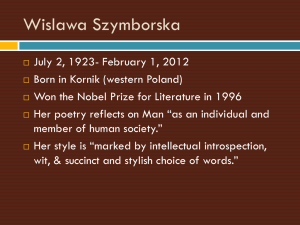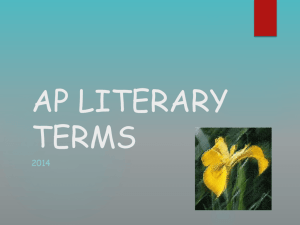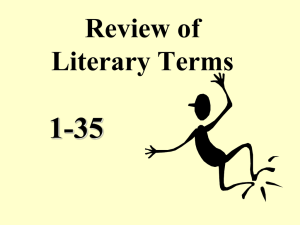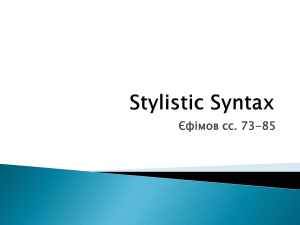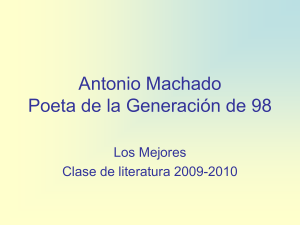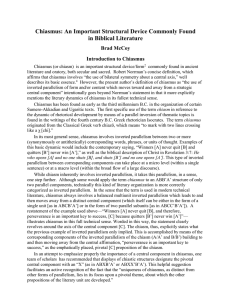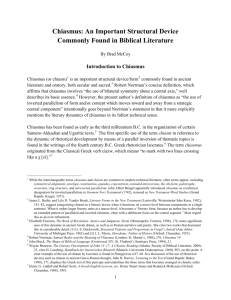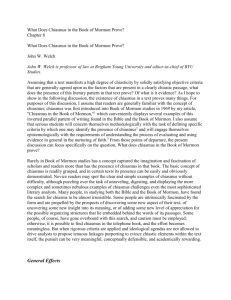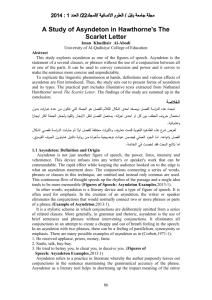Syntax and Style
advertisement
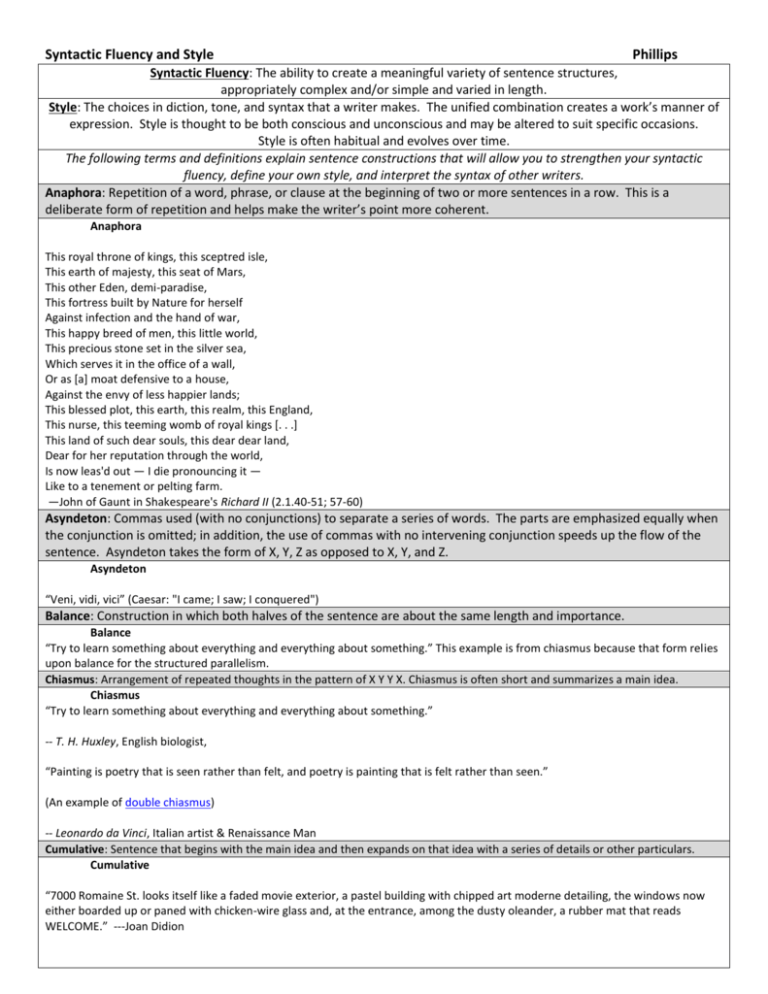
Syntactic Fluency and Style Phillips Syntactic Fluency: The ability to create a meaningful variety of sentence structures, appropriately complex and/or simple and varied in length. Style: The choices in diction, tone, and syntax that a writer makes. The unified combination creates a work’s manner of expression. Style is thought to be both conscious and unconscious and may be altered to suit specific occasions. Style is often habitual and evolves over time. The following terms and definitions explain sentence constructions that will allow you to strengthen your syntactic fluency, define your own style, and interpret the syntax of other writers. Anaphora: Repetition of a word, phrase, or clause at the beginning of two or more sentences in a row. This is a deliberate form of repetition and helps make the writer’s point more coherent. Anaphora This royal throne of kings, this sceptred isle, This earth of majesty, this seat of Mars, This other Eden, demi-paradise, This fortress built by Nature for herself Against infection and the hand of war, This happy breed of men, this little world, This precious stone set in the silver sea, Which serves it in the office of a wall, Or as [a] moat defensive to a house, Against the envy of less happier lands; This blessed plot, this earth, this realm, this England, This nurse, this teeming womb of royal kings [. . .] This land of such dear souls, this dear dear land, Dear for her reputation through the world, Is now leas'd out — I die pronouncing it — Like to a tenement or pelting farm. —John of Gaunt in Shakespeare's Richard II (2.1.40-51; 57-60) Asyndeton: Commas used (with no conjunctions) to separate a series of words. The parts are emphasized equally when the conjunction is omitted; in addition, the use of commas with no intervening conjunction speeds up the flow of the sentence. Asyndeton takes the form of X, Y, Z as opposed to X, Y, and Z. Asyndeton “Veni, vidi, vici” (Caesar: "I came; I saw; I conquered") Balance: Construction in which both halves of the sentence are about the same length and importance. Balance “Try to learn something about everything and everything about something.” This example is from chiasmus because that form relies upon balance for the structured parallelism. Chiasmus: Arrangement of repeated thoughts in the pattern of X Y Y X. Chiasmus is often short and summarizes a main idea. Chiasmus “Try to learn something about everything and everything about something.” -- T. H. Huxley, English biologist, “Painting is poetry that is seen rather than felt, and poetry is painting that is felt rather than seen.” (An example of double chiasmus) -- Leonardo da Vinci, Italian artist & Renaissance Man Cumulative: Sentence that begins with the main idea and then expands on that idea with a series of details or other particulars. Cumulative “7000 Romaine St. looks itself like a faded movie exterior, a pastel building with chipped art moderne detailing, the windows now either boarded up or paned with chicken-wire glass and, at the entrance, among the dusty oleander, a rubber mat that reads WELCOME.” ---Joan Didion Syntactic Fluency and Style Phillips Diction: Word choice, particularly as an element of style. Different types and arrangements of words have significant effects on meaning. An essay written in academic diction would be much less colorful, but perhaps more precise than street slang. Reconsider the word choice in the example above and examine what might be reasonably inferred about 7000 St. Romaine given the cumulative arrangement and the selection of detail evidenced by the writer’s word choice. Elliptical: Sentence structure that leaves out something in the second half. (Ellipsis is the … we sometimes see in writing). Usually, there is a subject-verb-object combination in the first half of the sentence, and the second half of the sentence will repeat the structure but omit the verb and use a comma to indicate the ellipted (removed) material. Elliptical “Wind speed is obtained from antenna brightness temperature; rain rate, from the brightness temperature difference at two frequencies; and wind vector, from radar cross section.” Freight-train: Sentence consisting of three or more very short independent clauses joined by conjunctions. Freight-train "In a week or two, all would be changed, all (or almost all) lost; the girls would wear makeup, the horse would wear gold, the ring would be painted, the bark would be clean for the feet of the horse, the girl's feet would be clean for the slippers that she'd wear. All, all would be lost.” Inversion: Variation of the normal word order (subject first, then verb, then complement) that puts a modifier or the verb as first in the sentence. The element that appears first is emphasized more than the subject. Inversion “Gone was the wind that had brought us here.” “Tired is he who faithfully does all his work.” Isocolon. When parallel structures have the same number of words and sometimes even of syllables. Isocolon "His purpose was to impress the ignorant, to perplex the dubious, and to confound the scrupulous" ". . . but what else can one do when he is alone in a jail cell, other than write long letters, think long thoughts and pray long prayers?" --Martin Luther King, Jr. "Letter from Birmingham Jail" “A good student questions his teachers, studies his books, and learns his lessons.” Negative-positive: Sentence that begins by stating what is not true and then ending by stating what is true. Negative-Positive “A tragic writer does not have to believe in God, but he must believe in man.” —Joseph Wood Krutch, The Modern Temper Paradox: A seemingly contradictory statement that is actually true. This rhetorical device is often used for emphasis or simply to attract attention. Paradox "Why do you have to be a nonconformist like everybody else?" "There is no exception to the rule that every rule has an exception." "One martini is all right, two is too many, three is not enough." -James Thurber, Humorist Periodic: A sentence that places a main idea or central complete thought at the end of the sentence, after all introductory elements. Periodic “Crossing a bare common, in snow puddles, at twilight, under a clouded sky, without having in my thoughts any occurrence of special good fortune, I have enjoyed a perfect exhilaration.” —Ralph Waldo Emerson, Nature Syntactic Fluency and Style Phillips Polysyndeton: Sentence which uses and or another conjunction (with no commas) to separate the items in a series. Polysyndeton appears in the form X and Y and Z, stressing equally each member of the series. It makes the sentence slower and the items more emphatic than in the asyndeton. Polysyndeton “It was a hot day and the sky was very bright and blue and the road was white and dusty.” -Ernest Hemingway, A Farewell to Arms "In the beginning God created the heaven and the earth. And the earth was without form, and void; and darkness was upon the face of the deep. And the spirit of God moved upon the face of the waters. And God said, Let there be light: and there was light. And God saw the light, that it was good: and God divided the light from the darkness. And God called the light Day, and the darkness he called Night. And the evening and the morning were the first day." --Genesis 1:1-5 Repetition: Word or phrase used two or more times in close proximity. Consider how the repetition of “light” operates in the above passage from Genesis. Syntactic Permutation: Sentence structures that are extraordinarily complex and involved. This construction is often difficult for a reader to follow. Permutation “There was a feller here once by the name of Jim Smiley, in the winter of ’49 or may be it was the spring of ’50 I don’t recollect exactly, somehow what makes me think it was one or the other is because I remember the big flume wasn’t finished when he first came to camp; but any way, he was the curiosest man about always betting on any thing that turned up you ever see, if he could get any body to bet on the other side; and if he couldn’t he’d change sides.” – Mark Twain “The Celebrated Jumping Frog of Calaveras County” Tricolon: Sentence consisting of three parts of equal importance and length, usually three independent clauses. Tricolon “He was, indeed, in every sense of the word, a wise, a good and a great man.” -Thomas Jefferson, A letter on the character of George Washington
